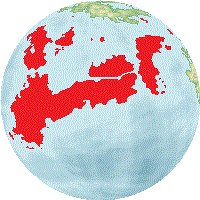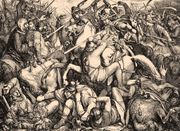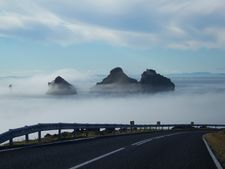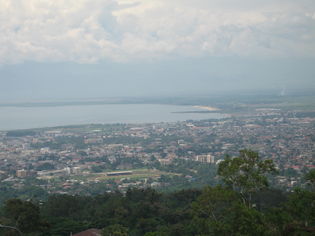Difference between revisions of "Nation/Amberian Islands"
| Line 98: | Line 98: | ||
===Colonial period (1903 until 1965)=== | ===Colonial period (1903 until 1965)=== | ||
| − | By the beginning of the 20th century Empire of Gatraenia dissolved and split into many independent states. However, before any separate political entity could be possibly created, colonial power Egraunia took over the islands and established an Egraunian Colony of Uswington which covered most of the area. In 1961, Uswington was granted partial autonomy by Egraunia and subsequently full independence on 23 September 1965 when The Republic of Uswington was formed. | + | By the beginning of the 20th century Empire of Gatraenia dissolved and split into many independent states. However, before any separate political entity could be possibly created, colonial power Egraunia took over the islands and established an Egraunian Colony of Uswington which covered most of the area. In 1961, Uswington was granted partial autonomy by Egraunia and subsequently full independence on 23 September 1965 when The Republic of Uswington was formed. Valeriy Asuilaak became the first president because he was the one who led the negotiations with Egraunia about the independence. |
===Post-colonial period=== | ===Post-colonial period=== | ||
| + | |||
| + | The Republic of Uswington was struggling with a great deal of problems right after its formation. For the first time in more than three centuries the country existed separately without belonging to another political entity and all those years have taken its toll. During Asuilaak's presidency, the economy of Uswington collapsed with almost none foreign investment being present. Factories stopped producing goods, the unemployment reached an all-time high, inflation rate was unheard of and public services were not functioning. This led to political unrest accompanied by many protests, riots and also a few unsuccessful attempts to bring down the government. Asuilaak was still holding the power in his hands and even though he tried to save the economy and stabilise the situation with numerous plans and agendas, all of them failed. In addition, many local figures of respective islands were heading towards autonomies based on different visions how the country should progress. | ||
| + | |||
| + | This turmoil culminated in 1972, when a radical leftist fraction of the army led by Colonel Yefrem Tattilgat organized a coup. They overthrew the government and took control over the whole island Chelyaluk. All the state figures including president Asuilaak were imprisoned. On 14 April 1972 the People's Republic of Ambriania was proclaimed. | ||
| + | |||
| + | Tattilgat abolished the National Council along with the Supreme Court, suspended the constitution and formed a Marxist-Leninist party known as Ambrianian Revolutionary Labor Party (ARLP) which became the sole ruling party. He also announced himself as a head of the state. All the other political parties were banned. | ||
| + | |||
| + | A couple of communist policies were introduced such as a nationalization of industry and land, extensive public works programme or reorganization of education. All bussiness and economic activities were under state control. Tattilgat's administration maintained power through a rule of fear by arresting individuals on a large-scale and harshly punishing anybody who opposed the regime. The state also established close relations with other socialist states. | ||
==Geography and climate== | ==Geography and climate== | ||
Revision as of 16:53, 22 August 2016
| This page is a work in progress by its author(s) and should not be considered final. |
The Republic of Amberian Islands
|
|||||
|---|---|---|---|---|---|
|
|||||
| Motto: "As one, we raise ourselves higher." | |||||
| Anthem: "Our jewel in the sea" | |||||
Location of the Amberian Islands (red) in Europeia
|
|||||
| Region | Europeia | ||||
| Capital and largest city | Arlinnguit | ||||
| Official languages | English | ||||
| Recognised national languages | Amberianic Inuktitut Russian |
||||
| Demonym | Amberianer | ||||
| Government | Unitary parliamentary republic | ||||
| - | President | Aleksandr Kayuqtuq | |||
| - | Prime Minister | Maxim Piqqluyungmik | |||
| Legislature | Great State Council | ||||
| History | |||||
| - | Kingdom of Ambriania | c. 938 | |||
| - | Kingdom of Uswington | c. 1326 | |||
| - | Empire of Gatraenia | 1598 - 1903 | |||
| - | Egraunian Colony of Uswington | 1903 - 1965 | |||
| - | The Republic of Uswington | 23 September 1965 | |||
| - | People's Republic of Ambriania | 14 April 1972 | |||
| - | State of Ambriania | 26 October 1990 | |||
| - | The Republic of Amberian Islands | 8 February 1994 | |||
| Area | |||||
| - | Total | 531,498 km2 205,213 sq mi |
|||
| - | Water (%) | 1.81% | |||
| Population | |||||
| - | 2016 estimate | 8,000,000 | |||
| - | Density | 15/km2 38.8/sq mi |
|||
| GDP (PPP) | 2016 estimate | ||||
| - | Total | $66.9 billion | |||
| - | Per capita | $8,358 | |||
| GDP (nominal) | 2016 estimate | ||||
| - | Total | $65.6 billion | |||
| - | Per capita | $8,196 | |||
| Gini (2016) | 58.72 high |
||||
| HDI (2016) | 0.52 low |
||||
| Currency | Amberianic dollar ( ABD) |
||||
| Time zone | Amberianic Standard Time (UTC+1) | ||||
| Date format | dd/mm/yyyy | ||||
| Drives on the | right | ||||
| Calling code | +4 695 | ||||
| ISO 3166 code | ABI | ||||
| Internet TLD | .abi | ||||
The Amberian Islands officially The Republic of Amberian Islands and formerly Uswington is an island country located in Europeia between the Olivine Sea and Crystal Ocean. A majority of the population live on its main island Chelyaluk. The capital of Amberian Islands is Arlinnguit which is also the country's largest city. The area covered is 531,498 square kilometres (205,213 square miles) and the country's population in 2016 was estimated to be approximately 8 million. The land has a subpolar oceanic climate but despite its northerly attitude, temperatures average above freezing because of the Jade stream. The islands' wealth is based on tourism with substantial employment and income coming from agriculture.
The official language of Amberian Islands is English. Original indigenous language Amberianic Inuktitut is still known amongst the people but not commonly spoken, it is used mostly on special purposes. There is also certain group of inhabitants speaking Russian. The largest religious group in Amberian Islands is Roman Catholicism, followed by Greek Catholicism and Orthodoxy. There is also considerable amount of people adhering to Protestantism and Heathenry. Amberian Islands are member of the World Assembly.
The first political entity established in the area that contained also parts of present-day Amberian Islands was Kingdom of Ambriania in the 10th century located in what is now southern Iasmuvania but included also islands Neryukiye and Kalunskoye along with small part of Tuymaryol. In the 14th century Kingdom of Uswington was found that covered significant part of island Chelyaluk extending also to Buynayugansk on its peak. For three centuries there wasn't an independent political entity on the islands because they were part of powerful Empire of Gatraenia. After its dissolution Egraunia took over the country and renamed it Egraunian Colony of Uswington. In 1965, Uswington gained full independence from Egraunia, however the period of political unstability followed with inability to keep islands unified.
A Marxist-Leninist state called People's Republic of Ambriania existed between 1972 and 1990. It was then replaced by temporary unit State of Ambriania which was created to once again integrate all the islands into one political entity. This was successfully acomplished in 1994 with the formation of current nation.
Contents
Etymology
During the colonial period and first years of independence, the country was known as Uswington which was the name of an ancient kingdom that once existed on the islands. On 14 April 1972 it was renamed to Ambriania reflecting the Kingdom of Ambriania. The new name, Ambriania, was chosen for numerous reasons. The main point was to distant the country from its colonial past and associate it with the mighty Kingdom of Ambriania, which was historically speaking the first kingdom that extended also to the area of the islands. After the unification of all the islands, it was decided to change the name to Amberian Islands which was derived directly from Ambriania.
History
Precolonial history
The present nation of Amberian Islands contains numerous islands that developed independently prior to Egraunian colonial control. In the 10th century, The Kingdom of Ambriania located mainly to the north of present Amberian Islands was the most prominent power in the region with strong military force and developed navy. They were known for their maritime explorations which they used as a source for finding new lands to raid and broaden their sphere of influence. Such raids were conducted also on islands Neryukiye and Kalunskoye which became the southernmost parts of the kingdom.
In the mainland there were only a few tribal regions and some not particularly important city states located mostly along the coast at that times. The situation changed in the 14th century as the Kingdom of Uswington was found on the island Chelyaluk and began taking over neighbourly areas. Towards the end of the 15th century it had conquered most of the island and in the early 16th century expanded its territorial lands also to island Buynayugansk under the reign of King Vjeran. After his death, the kingdom started to deteriorate with many internal conflicts happening which preceded the fall of the kingdom which was bound to happen soon.
Gatraenian Empire
During the years when Kingdom of Uswington was slowly gaining control in the mainland a new power was already emerging from the east. Empire of Gatraenia was established by the alliance of several kingdoms that existed in the area of present Gudruogua. Together they represented an immense power and were feared for their massive-scale army which was based on a long-time military tradition. After Empire of Gatraenia successfully seized all the neighbouring regions, it headed north where it defeated the Kingdom of Iasmuvania which was the only significant political entity in the territory after Kingdom of Ambriania dissolved.
Then it started to gain control of the islands without much resistance from local tribes. After getting control of islands Kamymbov and Chebozran it was decided to attack Kingdom of Uswington from two sides. One unit was sailing from Kamymbov and landed on the coast of western Chelyaluk and another one from Chebozran that landed on the coast of eastern Buynayugansk.
Kingdom of Uswington was far from its prime at that time after it was weakened by domestic problems and therefore couldn't properly defend itself. The most crucial fight occured in 1598 near the city Aappilatsat on the hill after which it is called the Battle of Veliylovka where the remaining portion of army and king's royal guard were beaten by Gatraenian forces. Defeat of the kingdom meant that finally all the islands were integrated into the empire and lost their independence for the next 300 years.
Colonial period (1903 until 1965)
By the beginning of the 20th century Empire of Gatraenia dissolved and split into many independent states. However, before any separate political entity could be possibly created, colonial power Egraunia took over the islands and established an Egraunian Colony of Uswington which covered most of the area. In 1961, Uswington was granted partial autonomy by Egraunia and subsequently full independence on 23 September 1965 when The Republic of Uswington was formed. Valeriy Asuilaak became the first president because he was the one who led the negotiations with Egraunia about the independence.
Post-colonial period
The Republic of Uswington was struggling with a great deal of problems right after its formation. For the first time in more than three centuries the country existed separately without belonging to another political entity and all those years have taken its toll. During Asuilaak's presidency, the economy of Uswington collapsed with almost none foreign investment being present. Factories stopped producing goods, the unemployment reached an all-time high, inflation rate was unheard of and public services were not functioning. This led to political unrest accompanied by many protests, riots and also a few unsuccessful attempts to bring down the government. Asuilaak was still holding the power in his hands and even though he tried to save the economy and stabilise the situation with numerous plans and agendas, all of them failed. In addition, many local figures of respective islands were heading towards autonomies based on different visions how the country should progress.
This turmoil culminated in 1972, when a radical leftist fraction of the army led by Colonel Yefrem Tattilgat organized a coup. They overthrew the government and took control over the whole island Chelyaluk. All the state figures including president Asuilaak were imprisoned. On 14 April 1972 the People's Republic of Ambriania was proclaimed.
Tattilgat abolished the National Council along with the Supreme Court, suspended the constitution and formed a Marxist-Leninist party known as Ambrianian Revolutionary Labor Party (ARLP) which became the sole ruling party. He also announced himself as a head of the state. All the other political parties were banned.
A couple of communist policies were introduced such as a nationalization of industry and land, extensive public works programme or reorganization of education. All bussiness and economic activities were under state control. Tattilgat's administration maintained power through a rule of fear by arresting individuals on a large-scale and harshly punishing anybody who opposed the regime. The state also established close relations with other socialist states.
Geography and climate
Amberian Islands represent an island group that consists of 5 major islands and 18 smaller ones between the Olivine Sea and Crystal Ocean in northern Europeia with the closest neighbours being the southern parts of Iasmuvania and western parts of Gudruogua. The islands cover an area of 531,498 square kilometres (205,213 sq. mi) and although some lakes and rivers are present, they aren't that dominant. The highest point is Sibaylovka, which is 1,791 metres (5,875 ft) above sea level. All of the islands are inhabited.
With reference to the Köppen climate classification, the climate belongs to the class subpolar oceanic climate with a couple of areas having a tundra climate. However, this applies mostly to mountains. Even though coastal areas and lowlands can have climate that resembles the tundra, it is mostly very mild in comparison. The basic character of climate is significantly influenced by the Crystal Ocean, which produces the North Crystal Current. This fact ensures that winters are generally mild (mean temperature around 4.0 to 5.0 °C or 39.2 to 41.0 °F) while summers can be characterised as cool (mean temperature around 9.0 to 11.5 °C or 48.2 to 52.7 °F). In general, the islands experience a lot of wind, which can get really strong at times and mostly cloudy sky with intense rain occuring at all times of the year. Sunny days are not so frequent with 150 annual rainy days on average. In spite of these specifications, islands haven't experienced occurences such as intense hurricanes in its history.
Due to factors such as topography and altitude in addition to ones mentioned before, the climate can vary greatly even over smaller distances. Sometimes heavy rain is falling in one area and another area located closely can have no precipitation at all. Another example of this phenomena is rain in one area and falling snow in another that is near. Another thing that can be observed is fog that obscures area with clouds at a very close distance to a certain area, which means elevations above and below it are left unobscured.
| Climate data for Arlinnguit (1980–2015, extremes 1967–2015) | |||||||||||||
|---|---|---|---|---|---|---|---|---|---|---|---|---|---|
| Month | Jan | Feb | Mar | Apr | May | Jun | Jul | Aug | Sep | Oct | Nov | Dec | Year |
| Record high °C (°F) | 11.8 (53.2) |
12.3 (54.1) |
12.5 (54.5) |
18.6 (65.5) |
19.9 (67.8) |
20.4 (68.7) |
20.6 (69.1) |
22.3 (72.1) |
19.8 (67.6) |
15.7 (60.3) |
14.9 (58.8) |
13.5 (56.3) |
22.3 (72.1) |
| Average high °C (°F) | 6.0 (42.8) |
6.2 (43.2) |
6.4 (43.5) |
7.5 (45.5) |
9.3 (48.7) |
11.4 (52.5) |
13.0 (55.4) |
13.6 (56.5) |
11.8 (53.2) |
9.6 (49.3) |
7.5 (45.5) |
6.4 (43.5) |
9.06 (48.31) |
| Daily mean °C (°F) | 4.2 (39.6) |
4.5 (40.1) |
4.7 (40.5) |
5.3 (41.5) |
7.4 (45.3) |
9.3 (48.7) |
10.9 (51.6) |
11.4 (52.5) |
9.8 (49.6) |
7.6 (45.7) |
5.8 (42.4) |
4.5 (40.1) |
7.12 (44.81) |
| Average low °C (°F) | 1.9 (35.4) |
2.1 (35.8) |
2.2 (36.0) |
3.4 (38.1) |
5.3 (41.5) |
7.5 (45.5) |
9.4 (48.9) |
9.8 (49.6) |
7.9 (46.2) |
5.6 (42.1) |
3.5 (38.3) |
2.8 (37.0) |
5.12 (41.21) |
| Record low °C (°F) | −10.6 (12.9) |
−9.5 (14.9) |
−8.7 (16.3) |
−7.3 (18.9) |
−2.4 (27.7) |
0.9 (33.6) |
1.7 (35.1) |
2.0 (35.6) |
−0.1 (31.8) |
−3.8 (25.2) |
−6.5 (20.3) |
−8.2 (17.2) |
−10.6 (12.9) |
| Precipitation mm (inches) | 137.4 (5.409) |
91.5 (3.602) |
111.8 (4.402) |
70.3 (2.768) |
43.0 (1.693) |
36.5 (1.437) |
53.4 (2.102) |
75.1 (2.957) |
98.3 (3.87) |
125.7 (4.949) |
118.9 (4.681) |
113.4 (4.465) |
1,075.3 (42.335) |
| % humidity | 80 | 78 | 77 | 75 | 78 | 79 | 81 | 77 | 75 | 77 | 79 | 78 | 77.8 |
| Avg. precipitation days | 18 | 13 | 17 | 11 | 8 | 6 | 7 | 7 | 12 | 15 | 18 | 19 | 151 |
| Avg. snowy days | 7.8 | 6.5 | 6.3 | 3.7 | 0.6 | 0 | 0 | 0 | 0 | 0.4 | 4.3 | 7.1 | 36.7 |
Politics
Administrative division
Amberian islands are divided into 23 districts which are based exactly on the borders of respective islands. These districts are assigned to 5 provinces which resemble the largest islands together with the ones that are around them.
| Map key | District | Province | Capital | Population (2016) | Area (km2) |
|---|---|---|---|---|---|
| 1 | Chelyaluk | Chelyaluk | Arlinnguit | --- | --- |
| 2 | Neryugulma | Chelyaluk | --- | --- | --- |
| 3 | Gelemkhovo | Chelyaluk | --- | --- | --- |
| 4 | Tyurzhinsk | Chelyaluk | --- | --- | --- |
| 5 | Kemerilsk | Chelyaluk | --- | --- | --- |
| 6 | Noyalovka | Chelyaluk | --- | --- | --- |
| 7 | Yekateyevka | Chelyaluk | --- | --- | --- |
| 8 | Nizhnetsk | Chelyaluk | --- | --- | --- |
| 9 | Tambotyevsk | Chelyaluk | --- | --- | --- |
| 10 | Chebozran | Chebozran | Kangerjaat | --- | --- |
| 11 | Naberkuta | Chebozran | Qasigianrasak | --- | --- |
| 12 | Yudrinsk | Chebozran | --- | --- | --- |
| 13 | Sarokutsk | Chebozran | --- | --- | --- |
| 14 | Kroposkoye | Chebozran | --- | --- | --- |
| 15 | Beryozyl | Chebozran | Sisirapaluk | --- | --- |
| 16 | Kamymbov | Kamymbov | Eqaluvik | --- | --- |
| 17 | Pervouylovka | Kamymbov | --- | --- | --- |
| 18 | Buynayugansk | Buynayugansk | Siqornat | --- | --- |
| 19 | Tuymaryol | Tuymaryol | Uummantut | --- | --- |
| 20 | Vorkuchny | Tuymaryol | Ikaniarfik | --- | --- |
| 21 | Neftebodny | Tuymaryol | --- | --- | --- |
| 22 | Neryukiye | Tuymaryol | --- | --- | --- |
| 23 | Kalunskoye | Tuymaryol | Qeqertarrasak | --- | --- |
Demographics
Largest cities
| Rank | Name | District | Population |
|---|---|---|---|
| 1 | Arlinnguit | Chelyaluk | --- |
| 2 | Eqaluvik | Kamymbov | --- |
| 3 | Kangerjaat | Chebozran | --- |
| 4 | Qanaarsuk | Chelyaluk | --- |
| 5 | Igalisut | Chelyaluk | --- |
| 6 | Siqornat | Buynayugansk | --- |
| 7 | Qassithal | Kamymbov | --- |
| 8 | Nutaarlik | Buynayugansk | --- |
| 9 | Tasiupaluk | Chelyaluk | --- |
| 10 | Uummantut | Tuymaryol | --- |








